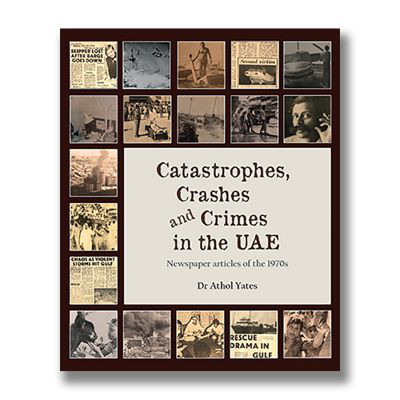
Catastrophes, Crashes and Crimes in the UAE: Newspaper Articles of the 1970s
By Athol Yates, Medina Publishers, 192 pages, $13
What’s the first image that comes to mind when you think of the UAE?
The tallest building in the world. Swanky shopping malls and world-class eateries. Twelve-lane expressways, with the latest cars cruising on them. Incredible infrastructure. The city that never sleeps. Top level security — you leave your car in a public parking spot for a month, and no one will touch it until you’re back. Yes, the UAE today is in several ways what an ideal country should be, with its modern infrastructure and world-class facilities.
It is hard to believe that a nation can achieve so much within just 45 years of its existence. Sometimes it really seems like the fabled story of Aladdin and his magic lamp, as if a genie has set up these wonderful new cities in the middle of the desert through his powerful magic.
Of course, the emirates themselves have existed for centuries. The UAE is very much a classical example of the type of nations discussed by Old Societies and New States by US anthropologist Clifford Geertz way back in 1965. Despite traditional social norms holding fort, the UAE remains a young nation at heart.
However, it is important to remember the current glitz and sheen has not happened overnight. As the country came into existence through the vision of the founding fathers, the rulers of the seven emirates, the early years were fraught with several difficult issues which the leaders had to deal with to bring the country to the level that it is at today.
“Catastrophes, Crashes and Crimes in the UAE: Newspaper Articles of the 1970s” by Dr Athol Yates catalogues these early years of the UAE’s formation, when the country was, literally, growing up and trying to find its feet. An assistant professor at the Khalifa University, Abu Dhabi, Yates led a team of volunteers at the National Archives in the capital to select the articles that find a place in the book.
The series of natural disasters in the early part of the 1970s mark a significant start of the book. The first few pages are rife with details of rainstorms and thundershowers wreaking havoc in various parts of the country. However, among those pages we also find how the country was taking first steps towards building its infrastructure. On July 25, 1975, a story tells us about the development of a sewerage system in Dubai, with Beirut-based Otak being awarded the contract by the Dubai Municipality. The story details how the 1-metre pipes being laid mark a “significant improvement” over the prevalent practice of draining sewage into the Creek. In similar vein, on June 28, 1978, we find a reference to Ras Al Khaimah building new barriers and raising the old ones to fend off the spate of tidal waves that hit the coastal regions a few days earlier.
Traffic crashes are a major problem for motorists in the UAE. The most horrific one took place on March 11, 2008, in which about 200 cars were involved in a pile-up on a foggy morning on the Dubai-Abu Dhabi highway. I remembered this as a history-repeats-itself incident as I read about a 12-car pileup near the Defence Force camp on March 15, 1977. We also read how the authorities were taking steps. On November 20, 1977, an article detailed how Dubai Police were clamping down on driving schools to ensure better standards. Also, we see the first steps towards improved regulation, with third party insurance cover becoming mandatory.
A significant issue during the early days of the UAE were plane hijacks. In 1977, a hijacked Boeing jet of German carrier Lufthansa landed in Dubai. Several stories provided details of the incidents as they unfolded. However, the most common theme underscoring all these were the efforts made by His Highness Shaikh Mohammad Bin Rashid Al Maktoum, Vice-President and Prime Minister of the UAE and Ruler of Dubai, who was then Minister of Defence, to secure the release of the passengers.
Political issues form a major part of the stories recorded in the book. On the day that the UAE formally came into existence, on December 2, 1971, we find a report about Iran’s brazen invasion of the Greater and Lesser Tumb islands. In another article, we read about the resistance put up by six member of the Ras Al Khaimah police against the attack. (Readers will recall the death of Mohammad Abdullah Al Khamiri Al Tuniji, one of these six heroic officers, on November 23). Several stories cover the birth pangs of the nation, as the border issues between the emirates and with Saudi Arabia were settled, primarily with the initiative of the late Shaikh Zayed Bin Sultan Al Nahyan.
As a fitting finale, some bizarre stories make for light but interesting reading. A haunted house in Deira, UFO sightings, a man who kidnapped a used-car salesman to show the vehicle to his wife, are among the notable ones that lend a hearty twist to the tale.
“Catastrophes, Crashes and Crimes in the UAE” is a glittering chronicle of the UAE’s initial years. As the seeds of the future lie in the past, the book serves as a useful guide to all those keen on the region’s history, one that is not found in history books.









